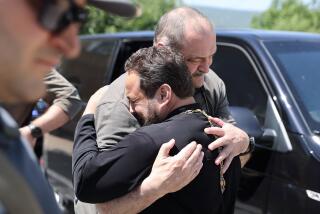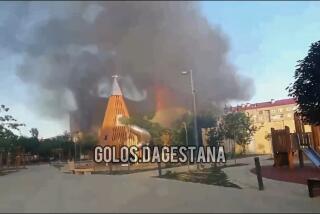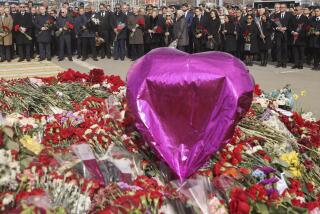Russia Uses Force in Bid to Put Down Insurgents
MOSCOW — Russia launched a powerful offensive Sunday against Muslim insurgents in its restive southern republic of Dagestan, trying to dislodge the rebels from four mountain villages and prevent the conflict from escalating to full-fledged warfare.
Russian troops and police used helicopter gunships and howitzers to shell positions seized by more than 1,000 Muslim fighters a day earlier when they crossed into Dagestan from bases in the separatist republic of Chechnya.
Four Russian servicemen were killed in the fighting and an additional 15 wounded, according to officials in Dagestan. There was no information about casualties among the rebels.
The fighting is the worst in Russia’s Caucasus region since Moscow’s war against Chechnya ended in 1996 with an uneasy truce. Chechnya remains out of Moscow’s control, and Chechen leaders have been unable to rein in field commanders who have conducted raids and kidnappings in neighboring republics, including Dagestan.
Top Kremlin leaders, among them Prime Minister Sergei V. Stepashin, rushed to the region Sunday to try to contain the crisis. Stepashin, who was one of the country’s leading hawks during the Chechen war, insisted that he will not let Dagestan become another Chechnya.
“The [Chechen war] years scare some people. Some are afraid of shouldering responsibility,” Stepashin said. “I’m not scared.”
Overall, Russian officials were taking a hard line.
“You know our position, and it’s a tough one,” said Interior Minister Vladimir B. Rushailo, whose troops were leading the offensive. “The bandits must be destroyed.”
The affiliation and goals of the insurgents remained in dispute Sunday. Russian officials described the rebels as a motley group of Chechens, Dagestanis and foreigners led by two famous Chechnya-based field commanders acting with at least the tacit support of the Chechen government.
The Itar-Tass news agency reported that the head of the Botlikh region, where the four villages are located, met in person with one of the commanders, Shamil Basayev, who was present in one of the villages.
Russian officials also accused the insurgents of being supported by “foreigners”--presumably wealthy patrons in Saudi Arabia or other Muslim countries. The officials cited the attackers’ heavy weaponry--two armored personnel carriers and antitank and antiaircraft missiles--as evidence of outside support.
“They have everything they need, and it is of much better quality than what the federal troops are equipped with,” said Mark Tolchinsky, a spokesman for the Dagestani Interior Ministry who spent Sunday at the front. “In fact, the only thing they don’t have is aircraft.”
Chechen government leaders continued to insist that the rebels are Dagestanis operating independently who want to establish an Islamic state in their impoverished homeland.
“All that is happening in Dagestan does not depend on us or on our influence,” said Kazbek Makhashev, Chechnya’s vice premier. “You can talk all you like about this or that commander . . . but [such talk] is not very objective information.”
Refugees, mostly women and children, streamed out of the area of the fighting, which included the villages of Ansalta, Rakhata, Akhino and Miarso. Some said the men who stayed behind in the villages were being held by the gunmen as hostages, but Tolchinsky said they had remained to defend their homes. There were reports this morning of more fighting in the region.
Rebel Commanders Known in Russia
The two commanders said to be leading the insurgents are well known in Russia. Basayev staged two violent hostage-taking raids into Russia, seizing a hospital in the town of Budennovsk in June 1995 and the village of Pervomaiskoye in January 1996. In both instances, Russian forces stormed his strongholds, and hundreds of people were killed in the fighting.
The second commander is known by the name Khattab. He is either a Jordanian or a Saudi national who has reportedly been training fighters in Chechnya since 1995. Refugees from the villages said fighters told them they launched the offensive to mark Khattab’s birthday, which fell on Saturday.
It is not known how many Dagestanis may support the rebels or the goal of separatism, but Dagestan’s political leadership is strongly pro-Moscow.
Still, tensions have been on the rise for months in Russia’s mountainous Caucasus region, which includes seven semiautonomous republics troubled by ethnic and religious conflict.
The most famous republic is Chechnya, which declared independence in 1991 and subsequently fought a guerrilla war against the Russian army that ended in a stalemate. Chechnya claims it is a sovereign state, but Moscow--along with the rest of the world--still considers it part of Russia.
Dagestan is an impoverished strip of grassland and mountains bordering the Caspian Sea that is home to about 2 million people from at least 30 ethnic groups, many of whom harbor long-standing grievances against Russia and one another.
Analyst Sees Chechen Hand Behind Attack
Murat D. Karaketov, an ethnologist with the Russian Academy of Sciences, scoffed at Chechnya’s assertions of noninvolvement in the Dagestani fighting. He described the incursion as an attempt by Chechnya to expand its territory, destabilize the region and gain formal recognition as a sovereign state.
“In Chechnya, secession of Dagestan from Russia and instability in the Caucasus has always been seen as something that would expedite the process of international recognition,” Karaketov said. “It is not an exaggeration to say the developments in Dagestan are the Chechen war, Part II.”
Karaketov also took issue with official descriptions of the insurgents as adherents of Wahhabism, a puritanical Islamic sect.
“What they have in Dagestan is not real Wahhabism but a separate trend that has some of its roots in Islamic fanaticism but has still retained many features of traditional Islam,” he said.
In practice, Karaketov added, religious identity in Dagestan is political: “Islam goes hand in hand with separatist convictions.”
More to Read
Sign up for Essential California
The most important California stories and recommendations in your inbox every morning.
You may occasionally receive promotional content from the Los Angeles Times.










